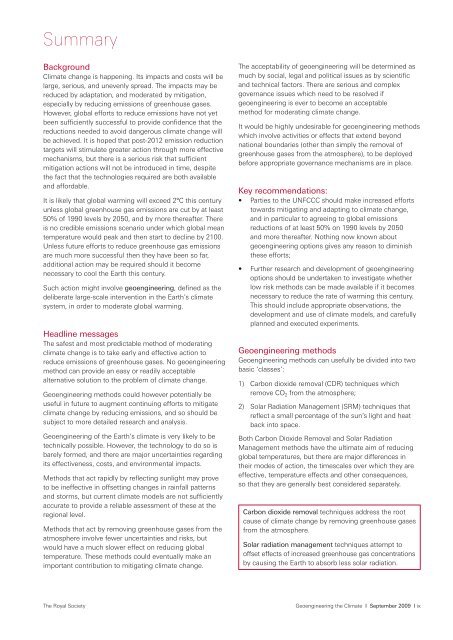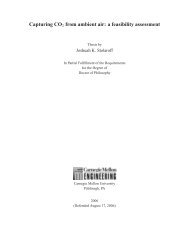Royal Society - David Keith
Royal Society - David Keith
Royal Society - David Keith
You also want an ePaper? Increase the reach of your titles
YUMPU automatically turns print PDFs into web optimized ePapers that Google loves.
Summary<br />
Background<br />
Climate change is happening. Its impacts and costs will be<br />
large, serious, and unevenly spread. The impacts may be<br />
reduced by adaptation, and moderated by mitigation,<br />
especially by reducing emissions of greenhouse gases.<br />
However, global efforts to reduce emissions have not yet<br />
been sufficiently successful to provide confidence that the<br />
reductions needed to avoid dangerous climate change will<br />
be achieved. It is hoped that post-2012 emission reduction<br />
targets will stimulate greater action through more effective<br />
mechanisms, but there is a serious risk that sufficient<br />
mitigation actions will not be introduced in time, despite<br />
the fact that the technologies required are both available<br />
and affordable.<br />
It is likely that global warming will exceed 2°C this century<br />
unless global greenhouse gas emissions are cut by at least<br />
50% of 1990 levels by 2050, and by more thereafter. There<br />
is no credible emissions scenario under which global mean<br />
temperature would peak and then start to decline by 2100.<br />
Unless future efforts to reduce greenhouse gas emissions<br />
are much more successful then they have been so far,<br />
additional action may be required should it become<br />
necessary to cool the Earth this century.<br />
Such action might involve geoengineering, defined as the<br />
deliberate large-scale intervention in the Earth’s climate<br />
system, in order to moderate global warming.<br />
Headline messages<br />
The safest and most predictable method of moderating<br />
climate change is to take early and effective action to<br />
reduce emissions of greenhouse gases. No geoengineering<br />
method can provide an easy or readily acceptable<br />
alternative solution to the problem of climate change.<br />
Geoengineering methods could however potentially be<br />
useful in future to augment continuing efforts to mitigate<br />
climate change by reducing emissions, and so should be<br />
subject to more detailed research and analysis.<br />
Geoengineering of the Earth’s climate is very likely to be<br />
technically possible. However, the technology to do so is<br />
barely formed, and there are major uncertainties regarding<br />
its effectiveness, costs, and environmental impacts.<br />
Methods that act rapidly by reflecting sunlight may prove<br />
to be ineffective in offsetting changes in rainfall patterns<br />
and storms, but current climate models are not sufficiently<br />
accurate to provide a reliable assessment of these at the<br />
regional level.<br />
Methods that act by removing greenhouse gases from the<br />
atmosphere involve fewer uncertainties and risks, but<br />
would have a much slower effect on reducing global<br />
temperature. These methods could eventually make an<br />
important contribution to mitigating climate change.<br />
The acceptability of geoengineering will be determined as<br />
much by social, legal and political issues as by scientific<br />
and technical factors. There are serious and complex<br />
governance issues which need to be resolved if<br />
geoengineering is ever to become an acceptable<br />
method for moderating climate change.<br />
It would be highly undesirable for geoengineering methods<br />
which involve activities or effects that extend beyond<br />
national boundaries (other than simply the removal of<br />
greenhouse gases from the atmosphere), to be deployed<br />
before appropriate governance mechanisms are in place.<br />
Key recommendations:<br />
• Parties to the UNFCCC should make increased efforts<br />
towards mitigating and adapting to climate change,<br />
and in particular to agreeing to global emissions<br />
reductions of at least 50% on 1990 levels by 2050<br />
and more thereafter. Nothing now known about<br />
geoengineering options gives any reason to diminish<br />
these efforts;<br />
• Further research and development of geoengineering<br />
options should be undertaken to investigate whether<br />
low risk methods can be made available if it becomes<br />
necessary to reduce the rate of warming this century.<br />
This should include appropriate observations, the<br />
development and use of climate models, and carefully<br />
planned and executed experiments.<br />
Geoengineering methods<br />
Geoengineering methods can usefully be divided into two<br />
basic ‘classes’:<br />
1) Carbon dioxide removal (CDR) techniques which<br />
remove CO 2 from the atmosphere;<br />
2) Solar Radiation Management (SRM) techniques that<br />
reflect a small percentage of the sun’s light and heat<br />
back into space.<br />
Both Carbon Dioxide Removal and Solar Radiation<br />
Management methods have the ultimate aim of reducing<br />
global temperatures, but there are major differences in<br />
their modes of action, the timescales over which they are<br />
effective, temperature effects and other consequences,<br />
so that they are generally best considered separately.<br />
Carbon dioxide removal techniques address the root<br />
cause of climate change by removing greenhouse gases<br />
from the atmosphere.<br />
Solar radiation management techniques attempt to<br />
offset effects of increased greenhouse gas concentrations<br />
by causing the Earth to absorb less solar radiation.<br />
The <strong>Royal</strong> <strong>Society</strong><br />
Geoengineering the Climate I September 2009 I ix








